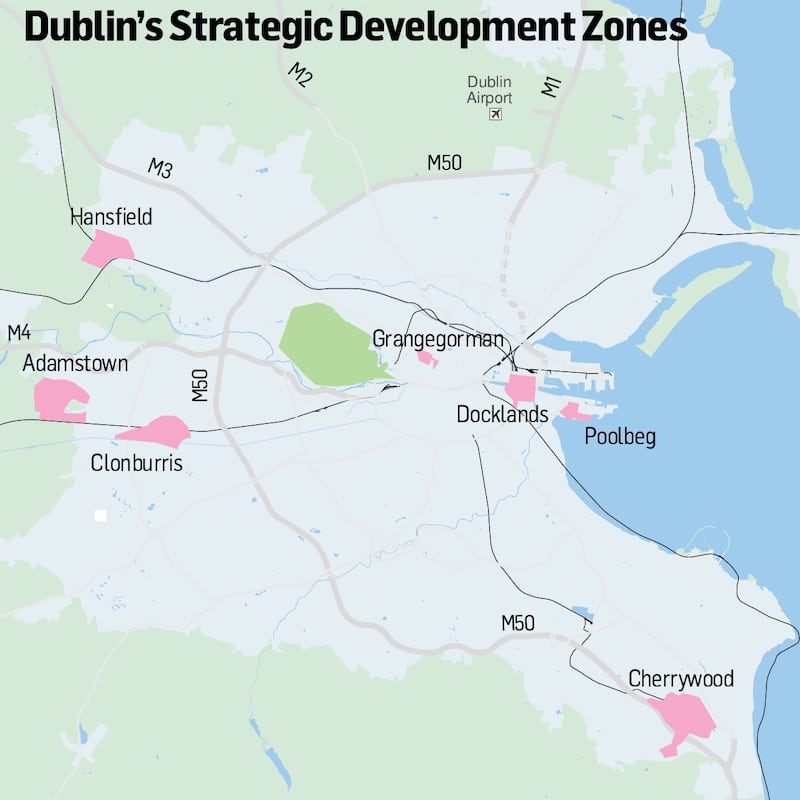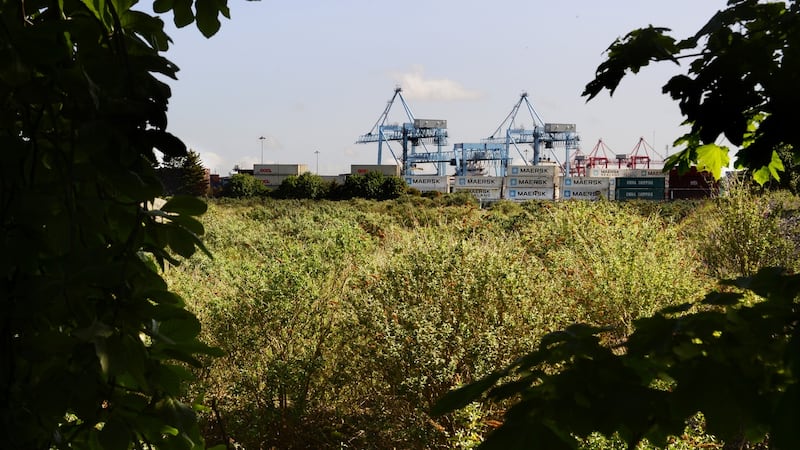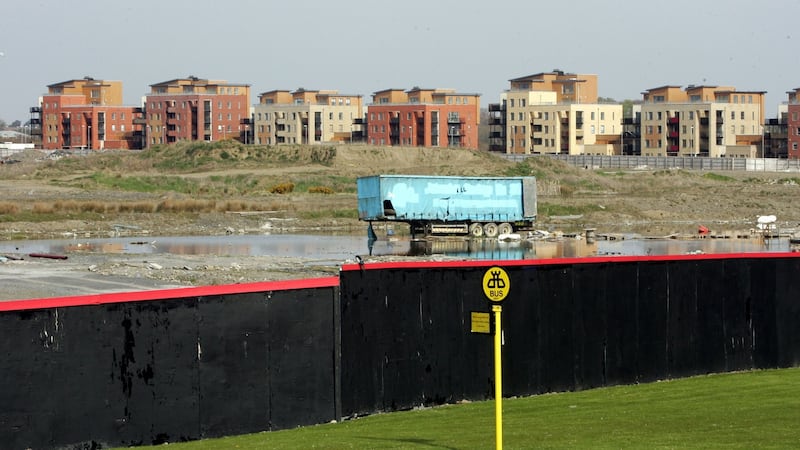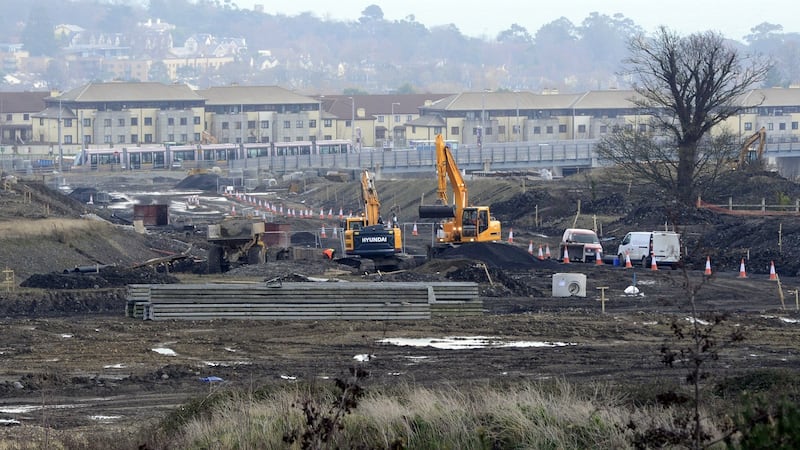Shannon in Co, Clare was for decades the State’s only modern planned town. Developed throughout the 1970s alongside Shannon Airport and the Shannon Free Zone industrial estate, it finally got its town status in 1982.
But the idea of the planned “new town” didn’t really catch on. While new towns had proliferated in Britain after the second World War, Ireland favoured a more laissez faire approach to residential development; new estates were tacked on to existing small towns and villages, and large new suburbs were created in Dublin and its surrounding counties.
The planned town concept didn’t emerge again until the start of this century with the advent of “strategic development zones” or “SDZs” in planning-speak.

SDZs, part of the Local Government (Planning and Development) Act, 1999, were originally intended for large-scale office or tech-industry developments. The hope was that more multinationals would be coaxed to Ireland if planning was quicker.
However, in 2000 economist Peter Bacon, in the third of his reports on the housing market, suggested SDZs could have a role in boosting housing supply and calming the then rapidly-heating housing market.
The system dictated that everything needed for a new town would be planned up front; the number and type of homes, schools, shops, sports and community facilities, transport services and other infrastructure.
The towns would be developed in phases, with developers having to complete the facilities required in each phase before they could move to the next tranche of housing.
Large schemes
The quid pro quo was that developers would secure planning decisions at a far faster rate. At the time decisions on large schemes took more than a year. Almost every local authority decision on a large-scale housing application was appealed to Bord Pleanála, and many were rejected in the end.
Once a SDZ was approved by a local authority it could be appealed to Bord Pleanála, but if it was passed by the board there could be no further appeal mechanism. Any landowner whose plans were in line with the SDZ would get permission to develop, generally within two months of lodging their application.
By 2006 the first homes had been occupied. Schools and a train station followed
Local authorities were sent to scope out suitable sites, places with good transport links that could support a large population, and that could stand alone without overwhelming an existing town.
South Dublin County Council was the first of the mark with a development in Adamstown in west Dublin. In 2001 the government designated 220 hectares for the development of a town of more than 10,000 homes. In September 2003, the State's first SDZ was approved by Bord Pleanála. By 2006 the first homes had been occupied. Schools and a train station followed.
Around 7km north of Adamstown, Fingal County Council was pursuing another zone for 3,000 homes on an 80-hectare site at Hansfield, west of Blanchardstown. This smaller development took longer and was approved by Bord Pleanála in 2006. A train station opened and schools were built.
Local area plan
Also in 2006, South Dublin County Council put forward plans for an even more ambitious SDZ at Clonburris to the east of Adamstown. This zone of 11,500 homes would be combined with a local area plan for 3,500 on neighbouring lands to form a new high density “eco-district”.

In 2008, as the economic crash loomed, Bord Pleanála approved the Clonburris SDZ.
The subsequent collapse of the property market put these plans in disarray. In Adamstown just over 1,000 homes were built. Not many more than 100 materialised in Hansfield. None transpired in Clonburris.
As was the case with almost every site in the State, the SDZ projects made no progress through the recession. However, Niall Cussen, principal planning adviser with the Department of Housing, says these were not wasted years.
“The advantage was we had time to do the preparatory work to get the sites ready for housing. Imagine trying to tackle the housing crisis today without having done the preparation for Docklands, for Adamstown, for Cherrywood SDZs. Imagine if we were starting from scratch with the challenge of doubling housing output across dozens of small sites.”
The Docklands and Cherrywood SDZs were both confirmed by Bord Pleanála in 2014.
Dublin City Council secured its first SDZ, for the development of the DIT's new campus at Grangegorman in Dublin, in 2012.
Recovery
Development showed its first signs of recovery after the crash with the Docklands SDZ – a 66-hectare site spanning the Liffey and including the Grand Canal south of the river and the North Lotts area on the north side.
The council sought the SDZ designation following the transfer of responsibility for the area from the Dublin Docklands Development Authority (DDDA). Two-thirds of the area had already been developed under the DDDA, but many buildings, including the former Anglo Irish Bank headquarters, were unfinished.
Two or three years ago every one of those sites would have been abandoned
Within the 66 hectares about 22 hectares were available for development. Under the plan about 2,600 new homes and 300-350sq m of commercial space could be built.
The pace of development in that district has been “staggering”, Cussen says, with permissions already granted for almost all of the available land and most sites under construction.
“Two or three years ago every one of those sites would have been abandoned. In another two or three years it will all be completed.”
The SDZ has overseen the development of the shell of the Anglo building as the new headquarters of the Central Bank, and the construction of what will be Dublin's tallest office and residential buildings, the 73m Exo office block in the Point Village and the 79m Capital Dock apartment and office complex at Sir John Rogerson's Quay.
The pace of change was possible because most the lands had gone into receivership, and the National Assets Management Agency (Nama) was able to step in.
Single entity
Jim Keogan, who retired as head of planning with Dublin City Council last year and now works in Cork with planning consultants McCutcheon Halley, says this was a crucial factor in the success of the SDZ.
“With Nama in there you were effectively dealing with a single entity. SDZs work best where you don’t have fragmentation of land ownership, where there is engagement with and buy-in by land owners. Otherwise they will not be developed.”

This could explain the slow pace of the Cherrywood SDZ where there are around 10 owners. The scheme for more than 8,000 homes on 360 hectares was approved in the same year as Docklands SDZ, but the first application for homes, 242 apartments and 80 houses by William Neville & Sons, was made only in August this year.
Hines, the largest developer on the scene, has yet to submit an application for housing.
“There had to be agreement between the 10 landowners on how common infrastructure would be funded, and that was only approved by the council in June of this year,” says Hines Ireland’s senior managing director Brian Moran.
Hines would be lodging its first residential application in the next month, says Moran, for the town-centre development, which will have 1,300 apartments as well as a hotel, shops, offices and leisure facilities.
However, he said this did not mean nothing had been happening on the site. “We are currently building 5.6km of roads and utilities and 83 acres of parks, which are due to be finished by next spring.”
Clonburris
The two newest SDZs are at Poolbeg and Clonburris – the latter announced in recent days.
Poolbeg is a step ahead of Clonburris and is likely to come before Bord Pleanála before the end of this year. The plan for 34 hectares at the city’s east end centres on the former Irish Glass Bottle site and Fabrizia lands, which are under the control of Nama-funded receivers.
Progress has been made in Adamstown, with more than 1,400 homes built
“Again, because of the Nama involvement I would think Poolbeg has all the hallmarks of repeating the success of the Docklands SDZ,” Cussen says.
The previous SDZ for Clonburris was revoked after no development took place, and a new, more modest plan involves 8,000 homes at lower densities than previously planned.
Progress has been made in Adamstown, with more than 1,400 homes built, 200 houses under construction and planning permission for 800 more expected to be approved by the end of the year.
At Hansfield, 328 homes have been built, 236 are under construction and another 650 have planning permission, with new applications recently lodged for 150 more, according to Fingal County Council.
Hampered
The development of the SDZ sites was severely hampered by the crash, but they are progressing now. Are they the way forward for large developments in housing-crisis Ireland?
“With an SDZ you can direct resources to the maximum effect, but it is not a light-touch process. To do all forward planning through SDZs would be very time-consuming,” Cussen says.
The commitment required by the local authority in terms of staff and time is considerable, Keogan says, and the schemes are by their nature prescriptive.
“Given that SDZs provide certainty, they are not as flexible as a local area plan to change, to reflect changed circumstances. Making changes to an SDZ is a cumbersome and time-consuming process.”
The council was able to simply implement new Government policy which allowed lower densities
Local area plans are like smaller versions of a city or county development plan. They also set out heights, scales and types of development for an area, but, unlike the SDZ, applications go through the normal planning procedures.
The difference between the schemes was illustrated when the viability of apartment construction appeared not to recover post-crash. To address this issue in Adamstown the council had to return to Bord Pleanála to seek lower densities, a process that took more than a year and a half.
In the case of two large city council local area plan (LAP) areas – Clongriffin, where 12,000 homes were planned at the north fringe of the city, and Pelletstown, where 4,000 homes were planned between Ashtown and Cabra along the Royal Canal – the council was able to simply implement new Government policy which allowed lower densities.
These two areas were the first significant housing sites to emerge from the crash, and continue to see a steady stream of applications.
“We’ve a number of different sites on the go,” says Shane Daly, commercial director of Gannon Homes, which is building in Clongriffin.
Good relationship
He says SDZs have a value, but it is possible to develop a properly planned town without them. “Gannon homes honoured our commitment to put in the infrastructure in advance of the homes. Thought has gone into how people live, work and play. It’s achieved through having a good relationship between the developer, the architects and the council.”
A new system whereby applications for more than 100 homes can be made directly to Bord Pleanála also means that planning decisions, while not as rapid as in an SDZ area, can be delivered more quickly than previously.
President of the Irish Planning Institute Deirdre Fallon says while SDZa were "greatly hampered" by the economic circumstances of recent years, more could be done to smooth out some of the delays in their implementation.

“The biggest issue is the resources given to the implementation of SDZs, particularly when a local authority is dealing with a multiplicity of landowners and a complicated site.”
Hubert Fitzpatrick, director of housing and planning with the Construction Industry Federation, says the SDZ model has great potential to increase the housing supply but lessons need to be learned from the existing schemes if they are to be used on future sites.
Flexibility
“The SDZs are very rigid and over prescriptive when it comes to the phasing of infrastructure. We need to ensure that they have the necessary flexibility to deal with changing circumstances, particularly when there are large sites with lots of developers and a long lead-in time.
“The objective is to fast-track development, so there needs to be a mechanism to adjust the plans in conjunction with the local authorities. We also need to ensure the infrastructure requirement is not so high that it creates viability difficulties and development is made prohibitive.”
Lessons have been learned from the earlier years of the SDZs, Cussen said.
“We are learning from previous planning schemes what is and what is not economic to develop.
The new town at Clonburris would be built over 10 to 15 years
“In the current circumstances some of the densities and the scale of the development ambitions planned for Clonburris for 2008 will be by today’s parameters unrealistic, but I have every confidence the local authority will settle on a good planning framework for Clonburris.”
The main Clonburris developer, Cairn Homes, says it would begin the project early next year, but the SDZ is unlikely to be in place before late 2018. The new town at Clonburris would be built over 10 to 15 years.












